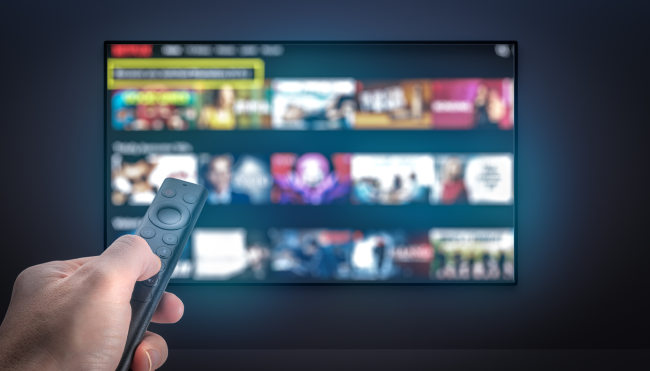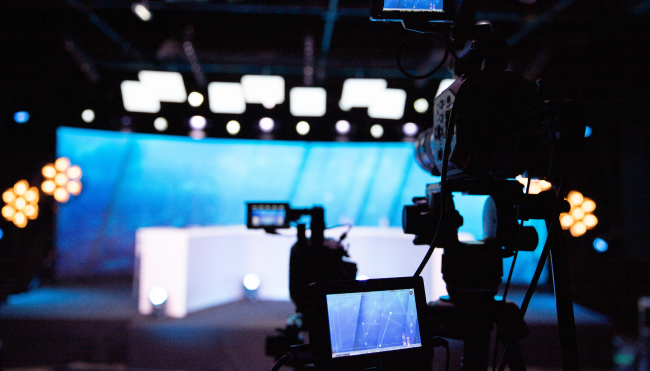- Why Amagi
-
Solutions
Contact UsBusinessWho We Serve
- Offerings
- AI
-
Resources
Contact UsINDUSTRY REPORTSAmagi FAST Report #15: The Power of Live Programming: A Catalyst for Streaming SuccessAugust 21, 2025Read More
-
Company
Contact UsNewsroomAmagi launches AI-powered Smart Scheduler to improve content programmingApril 3, 2025Read More
Blog
5 broadcast playout software tools (+ 10 features to look for)
By VinodKumar Ramachandran - August 30, 2022
From frame accuracy to dynamic graphics support, there are many important technical considerations when you’re choosing broadcast playout software (BPS). And that’s on top of the usual questions, like whether the software is from a trustworthy brand or if your team will like the user interface.
You also have to consider:
- Do you want on-premise software, or do you want to manage your operations in the cloud?
- Does it need to handle playout for traditional channels delivered over satellite, fiber, or IP?
- Does it need to handle playout for FAST and vMVPD platforms?
- Does it need to handle multi-channel delivery across different platform types?
- What costs and operational expenses can you afford?
To help you narrow down your options, we’ve included a guide to five broadcast playout software options (starting with our own, Amagi), along with an in-depth discussion of the 10 most important features to evaluate when you’re shopping for broadcast-grade playout software.
Amagi is a broadcast playout software that has all the features you'll need to successfully manage, deliver, and monetize linear channels on traditional TV and OTT platforms. If you want to create new linear channels or migrate your existing broadcasts to a cloud-native, unified, end-to-end solution, contact our team.
The 10 key features of broadcast playout software solutions

Here are the 10 most important considerations when shopping for broadcast tv playout software:
- High-quality video
- Frame accuracy
- Audio processing
- Dynamic graphics support
- Native captioning & subtitle support
- SCTE events
- Stream formats
- Latency
- Scheduling, playout, and live operational interface
- Frame accurate AsRun reports
If you already know all that, you can skip to our discussion on five of the top broadcast playout software solutions.
1) High-quality video
A good broadcast playout software must be able to deliver high-quality video, particularly if you create highly detailed content (such as National Geographic, Discovery Channel, etc.).
The ability to stream high-definition video is a must. Many solutions (including Amagi) are also able to stream in 4K.
Make sure that the BPS you choose is able to support all industry-standard video encoding formats, as it will affect your distribution strategy and stream quality.
Different regions require different encoding formats with which your broadcast channel must comply. For example, if you want to deliver your channel in the U.S., it'll need to support NTSC encoding (at 29.97 FPS). And if you want to deliver to Europe, it'll need to support PAL (at 25 FPS).
2) Frame accuracy
Frame accuracy refers to how your content transitions from videos to ads.
As an ad break approaches in your video feed, your broadcast platform will queue up an ad. That ad should begin immediately after the last frame (before the ad break) of your video. And your video should resume immediately after the last frame of the ad.
While this may seem like a subtle requirement, it's very important to the viewer experience and your ability to monetize content.
If the ad cuts into a scene in your content, it'll disrupt the viewing experience and potentially turn viewers away. If the video cuts into the ad and fails to deliver every single ad frame, advertisers may refuse to pay you for the impression. (More on this later.)
3) Audio processing
Your BPS should be able to support different audio formats required by the video service platform you deliver to, such as Stereo and Dolby 5.1. It must also include audio normalization support (aka loudness correction, which is a regulatory requirement in many markets).
Advertisers often use loud audio in their commercials to ensure that viewers will hear it and pay attention. Your playout software must have the functionality to correct the volume of commercials according to the requirements of different regions (e.g., the CALM Act in the U.S., EBU R128 in Europe, and so forth).
4) Dynamic graphics support

Dynamic graphics include graphic overlays like logo animations, promotion animations, and tickers.
Graphics like these are important for branding your channel and creating an enjoyable experience for viewers. But many BPS solutions don't include native graphics capabilities. In other words, if you choose one that doesn’t have native graphics support, you'll need to use a separate graphic solution software to insert graphics. And that forces you to spend more money on another vendor and increases the complexity of your broadcast delivery operation.
If your playout solution does include native graphics, it should also be able to support different types of media files (.png, .avi, etc.), be they images, video, audio, or templates.
At Amagi, we support complex dynamic video effects (DVE), real-time updates from an internet source, and ever-growing designs from graphics creators.
5) Native captioning & subtitle support

It's important that your BPS solution includes closed captions and subtitles capabilities that comply with the requirements of whatever market you want to broadcast your content to.
In the U.S., for example, your content is legally required to include closed captions for people with disabilities. And in Europe (where many different languages are spoken), you'll need subtitles that match the languages of the different countries that receive your broadcast.
If you're a broadcaster who wants to launch channels in multiple markets (as most do), you'll want a BPS that can meet the requirements for all of them.
6) SCTE events
SCTE events are triggers that mark when an ad should be played in a video stream and signal what’s currently playing. The SCTE events in your BPS must be frame-accurate to protect the viewing experience and improve your monetization potential.
From a technical perspective, your BPS player must generate SCTE events to enable downstream ad opportunities and signal what content is being played out. It must also interpret SCTE events in the live stream and generate playout actions accordingly.
Your BPS player should be able to insert local ads into an SCTE event depending upon where the viewer is. When you serve viewers relevant, local ads, they're more likely to convert. When more viewers convert from your content, you can charge more for ad impressions and potentially earn more revenue.
7) Stream formats
It's very important that your BPS deliver the stream in standard formats using various transport mechanisms such as SRT, RTP, RTP-FEC, NDI, SD 2110 - JPEG-XS, etc.
Playout providers deliver in one agreed-upon format using the specific transport required by the distribution. If your BPS doesn't support the format you want, you can't deliver to the receiver.
Using a BPS that supports a wide variety of stream formats and transport mechanisms ensures you can deliver to more receivers.
8) Latency
Latency is the delay between when an event occurs and when it is played out by the playout broadcaster.
If you're doing live video production or streaming (such as sporting events, esports, live interviews, news, etc.), you'll need a low-latency BPS. In these situations, high latency can create on-air delays that affect the viewing experience and how well your staff/talent works together (if working remotely).
For example, do your viewers want to know their team scored a goal from their Twitter feed or on the live TV feed you’re watching?
9) Scheduling, playout, and live operational interface
Your BPS should include scheduling features that enable you to:
- Plan EPGs (electronic programming guides) and integrate them with a playout platform.
- Integrate ad breaks, graphics, and promos.
- Integrate your program schedule into the broadcast network's workflow systems (for TV channels).
Some BPSs don't include a scheduling feature. Without it, you'll be forced to purchase and manage a separate scheduling tool, increasing the complexity of your broadcast operation.
And scheduling tools should be user-friendly — e.g., including drag-and-drop schedule building, a search engine for audio and video files, and so forth.
10) Frame accurate AsRun reporting
An AsRun report is a report of what was actually played out over the course of a broadcast playout. In other words, it's a record of what was aired and when.
AsRun reports are especially important with regard to ads, as they keep a record of:
- Whether ads were played.
- Whether ads were played completely (from the first to the last frame).
- When the ads were played (i.e., were they played at the intended time of day, such as prime time?).
You'll need AsRun reports to ensure advertisers render payment for their ads (which is why frame accuracy is so important to broadcast playout).
Five of the best broadcast playout software solutions
Now that you understand the key features to look for in broadcast playout software tools, let's review five of your options for broadcast playout software.
1) Amagi

Since we created this list, we thought we'd introduce our flagship solution first.
Amagi CLOUDPORT is an award-winning, broadcast-grade cloud playout platform that delivers to TV and OTT. Our software can be used to deliver linear channels over satellite, fiber, or IP.
Amagi CLOUDPORT can be deployed to manage live broadcasts and can ingest content from multiple live sources, while the digital video effects and advanced graphics make the experience even richer for the user.
As the most versatile playout platform available today, Amagi can ingest all industry-preferred formats for audio, video, and subtitles, as well as generate output in multiple formats.
Amagi has a 99.99% uptime, so you can be secure that your content and channels will always be available. Unlike many BPS options, Amagi is cloud-native, making it more reliable and cost-effective while ensuring broadcast-grade quality.
Amagi's superiority as a playout broadcaster lies in the fact that:
- We're a cloud-native solution whose broadcast-quality competes with on-premise solutions (high-quality dynamic graphics, the lowest latency of any cloud-playout software, high reliability/uptime) at a significantly lower cost.
- We're a unified end-to-end solution you can use to generate high-quality broadcast playout and deliver multiple channels to multiple platforms. You won't have to pay for or manage multiple vendors: Simply ingest your content into Amagi once and we'll handle playout automation, ad sourcing and delivery, dynamic graphic insertion, and more.
In other words, you can manage all your linear channels and VOD offerings for traditional TV, FAST, and vMVPD platforms from one interface with Amagi.
Playout

Amagi CLOUDPORT is a highly efficient asset management, processing, and delivery solution that's ideal for tv networks, sports, and news broadcasters who want to migrate their broadcast workflows to the cloud.
Migrating to CLOUDPORT is easy. Our onboarding team works with you to transition your entire ingest workflow. And Amagi can be used with MAM systems (like Omneon, Vizrt, and Harmonic) to automatically pull content into CLOUDPORT. That said, we can ingest content from any data source.
Our global delivery network of teleports, datacenters, and fiber or IP delivery partners makes us the fastest and most efficient launchpad for linear channel delivery on TV or OTT across the globe.
Our ‘built-on-cloud’ platform simplifies metadata management and provides unified broadcast workflows that equip broadcasters to reach both TV and OTT audiences using a common playout and automation engine. Users can:
- Regionalize channels to address viewer preferences, broadcast regulations, and content rights obligations.
- Broadcast live premium sports, college sports, and live events with rich graphics and orchestration capabilities. You can also record any live event for VOD playback later.
Scheduling

Amagi's PLANNER is a lightweight, drag-and-drop content scheduling platform that makes planning and scheduling content for TV easy and efficient (particularly as compared to traditional broadcast scheduling systems).
With Amagi PLANNER, a scheduler can input rules to create schedule patterns and easily create an EPG across multiple days in just a few clicks. EPGs are exported to CLOUDPORT where they can be viewed as a day-wise playlist with segment information and auto-scheduled ad breaks.
Ads
Amagi THUNDERSTORM is a dynamic ad insertion platform for OTT, vMVPD, and FAST platforms.
Amagi THUNDERSTORM can serve mid-roll, pre-roll, and post-roll ads. It works seamlessly with leading ad networks such as SpotX, Google DFP, Pubmatic, The Trade Desk, Telaria, and more.
While you can manually insert ads (via SCTE, DTMF Cue Tones, Packet31 ad insertion triggers), Amagi THUNDERSTORM can also use AI to detect and replace ads with more than 95 percent accuracy, even when ad triggers aren't available.
With Amagi THUNDERSTORM, you can monetize live sports by supporting tens of millions of simultaneous viewers using a high concurrency ‘hyperscale’ feature.

Plus, it provides real-time analytics on impressions, users, sessions, geography, and more, so you can determine which content is performing best and maximize ad revenue.
Additional technical capabilities
Video Quality:
Amagi can deliver video in HD and 4K and supports both NTSC and PAL video formats.
SCTE events & frame accuracy
With Amagi THUNDERSTORM, you can insert SCTE triggers and deliver frame-accurate ads that ensure you get paid while maintaining a quality viewing experience. Amagi THUNDERSTORM can also display personalized, local ads to help you increase your earning potential.
Audio support & normalization
Amagi supports both audio formats (stereo and Dolby 5.1) and audio normalization, so you can comply with the standards of the platforms and regions you deliver to.
Native graphics capabilities
While most of our competitors don't have native graphic capabilities, Amagi does. We use proprietary software to offer excellent graphics rendering from CPUs at a fraction of the cost of GPUs, savings which we then pass along to you.
Bottom Line: You get access to rich, dynamic graphics without having to pay and manage another vendor.
AsRun reporting
Amagi includes customizable AsRun reporting so you can monitor ads and/or content delivery to ensure you get paid.
Latency
Many Amagi competitors are plagued with heavy latency in their system for playout, especially for live streams. With an average latency of 3-4 seconds, Amagi has a much lower latency than most competitors. If you do live streams and events, Amagi is the best cloud playout provider for you.
Stream formats
Amagi supports a wide range of stream formats, like SRT RTP, RTP-FEC, NDI, ST 2110 With JPEG XS, and more. We can deliver to multiple different platforms in whatever format is required.
Captions & subtitles
Amagi can meet the caption and subtitle requirements of any market. We can support more captions and subtitles than competitors:
- Up to 6 captions in the U.S.
- Unlimited subtitles in the EU.
Amagi also uses speech-to-text software to dynamically generate captions for live sports events.
Further reading: Amagi provides UHD playout for Tokyo Olympics for NBC sports
Did you know that Amagi provided UHD playout for NBC Sports as they covered the Tokyo Olympics? We can provide high quality broadcast level playout anywhere in the world. If you want to create new linear channels or migrate your existing broadcasts to a cloud-native, unified, end-to-end solution, contact our team.
2) Grass Valley

Grass Valley is a traditional, on-premise broadcast playout provider that has its hands in almost every aspect of the broadcast market. You can buy physical equipment — cameras, servers, audio mixers, and the like — or buy media storage through their media asset management (MAM) software. They also offer cloud production platforms, enabling content owners and service providers to create and deliver live experiences efficiently.
What specs and support you get depends on which of their multiple hardware offerings you invest in. They sell broadcast automation software, dual- or single-channel playout hardware and software, master control technology, and others. Consider Grass Valley if you still want to invest heavily in the on-premise, control room style of broadcasting.
According to their published product info, some of the features on their software-only playout solution include…
- Multiple back to back file codec and wrapper formats.
- Full Master Control functionality via Morpheus UX control panels
- Multiple DSKs and DVEs.
- Still and animated logos and 3D graphics.
- Dolby E decode and encode.
- Closed captions and subtitles.
3) Frequency

Frequency provides cloud playout for linear channels to FAST platforms. They support 4k playout, live events, graphics insertion, ad insertion, and basic scheduling functionality. Their platform is lightweight and has fewer options than most of the solutions mentioned elsewhere in this post.
Frequency can ingest MRSS, SFTP, S3, Dropbox, or manually uploaded files. Some capabilities include…
- Audio normalization
- Ad marker insertion
- Closed captions and subtitles (CEA-608/708)
- HLS Output, MPEG-DASH Output, and RTMP Output
4) Evertz

MEDIATOR X (by Evertz) is a traditional BPS that offers asset management, linear playout, playout automation software, and OTT (linear and VOD) delivery via cloud-based infrastructures as well as on-premise hardware. New channels can be configured and launched from within the Mediator-X configuration tool, and their RenderX transcoders can be automatically launched and shut down to meet fluctuating nonlinear distribution workloads.
Among its many uses, MEDIATOR X enables you to import schedules and export AsRun data in multiple formats. Their platform also enables you to collect metadata once, drive workflows from schedule times, construct non-linear assets straight out of the linear schedule, and much more.
Other important BPS features include:
- Audio management capabilities.
- High-quality native graphics support, including for live feeds.
- Subtitle and closed caption support.
- Supports multiple frame rates as well as compressed and uncompressed video/audio.
Like Grass Valley, Evertz is traditionally a player in the on-premise broadcast space. Choosing them will mean a heavier tech investment than with a cloud-based provider.
5) Wurl

Wurl is a cloud-only playout software solution. They offer stripped down functionality for live, linear, and VOD streaming. If you use their managed services, they also provide content normalization, protection and quality control; quality control for your metadata, playout management, and monitoring of your distribution and monetization.
And they advertise playout to 50+ platforms. Wurl is a good choice for very small channels that don’t need much flexibility in scheduling and only need basic functions for their broadcast. Any advanced or complex needs will be better served by a provider like Amagi.
Deliver linear channels with Amagi
Amagi CLOUDPORT enables you to manage, process, and deliver assets efficiently via our global delivery network. From one unified broadcast workflow, you can deliver pre-recorded or live events on TV and OTT platforms, regionalize your content to viewer and regulatory preferences, insert high-quality graphics, manage video and audio quality, and more.
Amagi PLANNER enables you to easily create EPGs using a drag-and-drop interface, input rules to create schedule patterns, and integrate schedules into Amagi CLOUDPORT playout.
Amagi THUNDERSTORM enables you to monetize your content with mid-roll, pre-roll, and post-roll ads served via manually inserted ad triggers, AI-based ad detection, and our high-concurrency 'hyperscale' feature (for delivering ads to live sports).
Our onboarding team will work with you to transition your entire ingest workflow or automatically pull content from your current MAM so you can begin managing your entire linear and OTT distribution operation from one unified location.
To talk to our team about whether Amagi is the right solution for you, contact us now.
Related Blogs
Get started
Increase revenue and reach with our Broadcast & Streaming solutions.
Cloud modernization. Streaming unification. Monetization. Marketplace.
 German
German French
French Spanish
Spanish Korean
Korean Japanese
Japanese Portuguese
Portuguese


